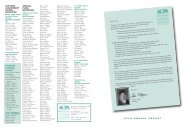Learning Reconsidered - ACPA
Learning Reconsidered - ACPA
Learning Reconsidered - ACPA
Create successful ePaper yourself
Turn your PDF publications into a flip-book with our unique Google optimized e-Paper software.
CHAPTER 4<br />
DEVELOPING LEARNING<br />
OUTCOMES<br />
Susan R. Komives<br />
Sarah Schoper<br />
INTRODUCTION<br />
The story is told of the city slicker who gets<br />
off the train in a small mountain town. He notices<br />
a youth down the street who is taking pot shots<br />
with a BB gun at various targets (the side of a<br />
barn, a picket fence, and a stop sign). The youth<br />
then walks up to the target and appears to study the<br />
shot, and moves on. Approaching the first target,<br />
the visitor is impressed to note that the shot is<br />
dead center in the middle of a bull’s eye. The<br />
same is true with each target! He catches up with<br />
the youngster and says, “Young lady, I am very<br />
impressed with your shooting. How did you learn<br />
to shoot that well?” She pauses a moment and<br />
says, “Aw, shucks, it ain’t nothing. I shoot first and<br />
draw a circle around the hole later.”<br />
That story leads us to ask what changes<br />
would occur in our work—and, indeed, across our<br />
institutions—if we were to identify the target first<br />
(i.e., specify desired, intended outcomes), and<br />
then design programs, strategies, and other college<br />
experiences that would contribute to those outcomes.<br />
This chapter will explore the context of the<br />
outcomes movement, describe the kinds of learning<br />
outcomes sought in higher education, and<br />
suggest techniques to assist your department,<br />
division, or entire campus focus on identifying<br />
and designating outcomes.<br />
THE STUDENT OUTCOMES MOVEMENT<br />
IN CONTEXT<br />
The growing and vibrant interest in student<br />
outcomes (often called student learning outcomes)<br />
17<br />
is the product of thought and action in several converging<br />
themes over the past 20 years. Understanding<br />
the convergence of these interconnected themes<br />
illustrates the complexity of this new emphasis.<br />
1. Reform movements. Reform movements<br />
in higher education are closely linked to<br />
antecedent movements toward reform in<br />
K-12 education. After the publication of<br />
A Nation at Risk (1983)—the report that<br />
asked “Why can’t Johnny Read?”—the<br />
1980’s were filled with a series of higher<br />
education reform reports intended to<br />
examine and exhort post-secondary education<br />
to revisit its overall mission, examine<br />
general education, reframe institutional<br />
mission, reaffirm campus community,<br />
respond to growing diversity, and identify<br />
and assess outcomes. Reports such as<br />
Involvement in <strong>Learning</strong>, the Carnegie<br />
Commission’s report College (1987), and<br />
Reclaiming a Legacy documented the<br />
need for reform.<br />
2. Student <strong>Learning</strong> Movement. In the<br />
1980’s many reform reports admonished<br />
higher education to return to a focus on<br />
undergraduate education and the importance<br />
of quality teaching. Although many<br />
institutions had never deviated from that<br />
commitment, and indeed many considered<br />
it their primary purpose, large research<br />
universities enrolling most of the nation’s<br />
students were perceived as having strayed<br />
away from it. Barr and Tagg’s widely read<br />
Change magazine article, “From Teaching



